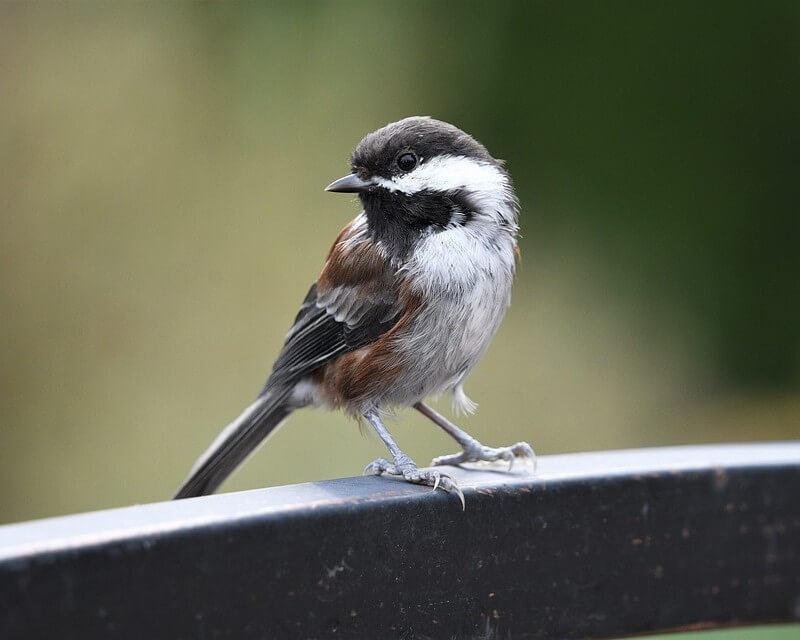From Portland to Fremont National Forest, the Beaver State is home to some amazing birds. With 545 species observed on ebird, Oregon’s changing seasons and vast geography provide for a diverse habitat. In this post, we’ll review 30 of the most common and colorful birds in Oregon along with some helpful data on when and where to find them.
We even sampled 5 years of aggregate data from ebird’s Oregon checklists to compile easy-to-use statistics and graphs to help identify each bird species. So whether you’re just watching the backyard bird feeder or venturing to birding hotspots like Malheur National Wildlife Refuge or Hatfield Lake – we’ll have you ready to start bird watching like a professional.
American Goldfinch

The American Goldfinch is a small finch with a short tail, widespread throughout North America.
- Carduelis tristis
- Size: 5″ (13cm)
- OR Checklist Frequency High: 24% in May
- OR Checklist Frequency Low: 4% in February
Identification and Color: A fan favorite at backyard feeders for its brilliant yellow color. A small, slim finch with a small bill and rounded wings. The back is black with white wing bars. Underparts are yellow with a black bill. The tail is white with black markings on the outer feathers.
Habitat and Behavior: The American Goldfinch nests and breeds in open woodlands, meadows, and fields. Commonly seen in gardens and parks. During the breeding season, the American Goldfinch is often seen in flocks. Known to hang upside down from branches while feeding. Typically nests late in the summer.
Diet: Strict vegetarian. The American Goldfinch feeds on tiny seeds, weeds and grasses. Enjoys nyjer and sunflower seeds. Rarely consumes insects.
American Robin
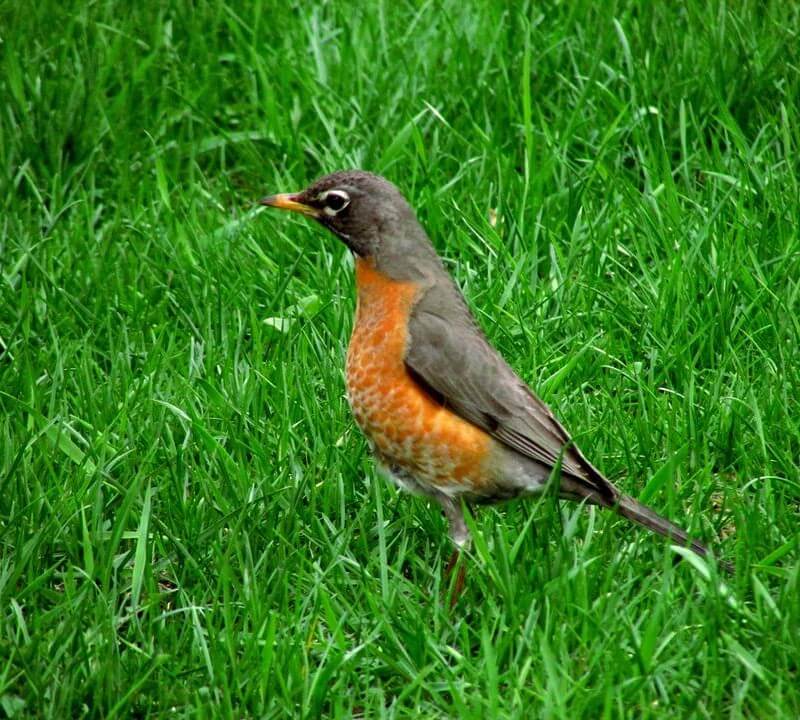
Abundant throughout the entire country and commonly a welcome indicator of spring in northern states. The American Robin is a common sight in Oregon.
- Turdus migratorius
- Size: 9-11″ (22.5-28cm)
- OR Checklist Frequency High: 52% in April
- OR Checklist Frequency Low: 23% in August
Identification and Color: Reddish-brown breast (almost looks pot-bellied) and grey back. The female usually has a lighter plumage than the male. Males have a darker black head.
Habitat and Behavior: The American Robin is found in open woodlands, gardens, and parks. It often forages for food on the ground cocking its head to the side in an effort to find worms. When it’s not eating, the American Robin can often be seen perched on a branch singing its cheerful song.
Diet: The American Robin feeds on insects, worms, berries, and fruits.
Anna’s Hummingbird

Anna’s Hummingbird is seen year-round in Oregon.
- Calypte anna
- Size: 4″ (10 cm)
- OR Checklist Frequency High: 32% in February
- OR Checklist Frequency Low: 13% in June
Identification and Color: Growing to only 4 inches in length, Anna’s Hummingbird is on the stocky side. They have a short, straight bill and long tail. Mostly green and grey, but males have iridescent pink around their heads. Both sexes have white on their undersides.
Habitat and Behavior: Found on the west coast year-round. Will visit feeders in gardens or parks. Can be located in open woods or by streams and rivers. They are very fast and can be hard to see while in motion. Will stop and hover over a flower or feeder to eat.
Diet: Anna’s Hummingbird diet consists of nectar and tiny insects.
Barn Swallow

The Barn Swallow is a small common songbird that is often seen swooping in flight. Typically found in Oregon during the summer months.
- Hirundo rustica
- Size: 7″ (17 cm)
- OR Checklist Frequency High: 30% in August
- OR Checklist Frequency Low: 1% in Winter
Identification and Color: Easily identified by its long forked tail. Has a shiny blue hood and back with orange underparts.
Habitat and Behavior: Found in fields and meadows, specifically for foraging. Can also be seen near lakes and ponds. These birds are attracted to barns and other buildings because they provide a safe place to build their nests. These birds are known for their aerial acrobatics and often perform flips and twists while flying.
Diet: The Barn Swallow feeds on insects, which it often catches in mid-air. Can also be seen skimming the water’s surface for a drink.
Bewick’s Wren

The Bewick’s Wren is a year-round resident of Oregon.
- Thryomanes bewickii
- Size: 5″ (13 cm)
- OR Checklist Frequency High: 18% in April
- OR Checklist Frequency Low: 10% in June
Identification and Color: Bewick’s Wrens have brown along their backs and wings with grey to white on their undersides. They have long tails with black spots and white spots on the sides. The bills are long, slender, and have a slight curve going down. Both sexes have similar coloring but some warmer climates may have a reddish brown color.
Habitat and Behavior: Found between the west coast and the southwest. Favors dry areas of underbrush, thickets, or scrub. Can be found in some populated areas. Will climb or jump through the brush to forage. During mating season males will sing from their perches.
Diet: Insects such as beetles, ants, or wasps make up the majority of the Bewick’s Wren diet. Will occasionally eat some berries or seeds.
Black-capped Chickadee

Black-capped Chickadees are small songbirds commonly found at feeders and nest boxes. Year-round residents of Oregon.
- Poecile atricapillus
- Size: 5.5″ (14 cm)
- OR Checklist Frequency High: 35% in December
- OR Checklist Frequency Low: 18% in May
Identification and Color: Easily distinguished by their black caps and white cheeks. They have grey bodies with light grey wings and tail feathers.
Habitat and Behavior: Typically inhabit woodlands where there are plenty of trees for them to nest and forage in. Commonly found in suburban areas and parks. Has no issue with harsh winters. Black-capped Chickadees are not timid birds and can easily be attracted to backyard bird feeders
Diet: Consists mainly of insects and other small invertebrates like caterpillars. Chickadees will also eat seeds and berries, especially in the winter months when food is scarce.
Bushtit

The Bushtit is a year-round resident of Oregon.
- Psaltriparus minimus
- Size: 4″ (10 cm)
- OR Checklist Frequency High: 18% in April
- OR Checklist Frequency Low: 7% in August
Identification and Color: The Bushtit is a lightly colored bird. Gray and white from the top of their heads to their backsides, a light brown patch on the face, and lighter brown and grey on their belly sides. Some males may have some black face markings. Tiny but plump birds with long tails and short bills.
Habitat and Behavior: Located along the west coast and southwest states. Generally permanent residents, but some in higher elevations may move for the season. Favor oak forests, wooded, or brushy areas. They move quickly and within groups and can be seen hanging upside down.
Diet: Bushtits enjoy tiny insects like ants, aphids, and small beetles. They will also eat berries and sometimes seeds.
California Scrub-Jay

The California Scrub-Jay can be seen year-round in Oregon.
- Aphelocoma californica
- Size: 11″ (28 cm)
- OR Checklist Frequency High: 36% in October
- OR Checklist Frequency Low: 17% in June
Identification and Color: The California Scrub-Jay has a rich blue and grey color on top with lighter white undersides. Depending on the lighting, the blue color can look very dark. A long tail and straight bill with a slight hook at the end of it.
Habitat and Behavior: Found on the west coast and a permanent resident of California as the name suggests. They can be found in open forests of oak and riverside woods. Often found perched very high up, they will forage in trees or on the ground.
Diet: The California Scrub-Jay has an omnivorous diet dependent on the season. Insects in the summer and seeds, nuts, and berries in the winter.
Cedar Waxwing

The Cedar Waxwing can be seen in Oregon year-round.
- Bombycilla cedrorum
- Size: 7.5″ (19 cm)
- OR Checklist Frequency High: 21% in August
- OR Checklist Frequency Low: 2% in Winter
Identification and Color: These birds truly have a variety of colors. A brown head, but with a black line across the eyes outlined in white. A dark grey top meets darker colors on the wings and tail feathers. Pale yellow belly. Red tips on their wings and bright yellow tip at the end of their tails. A short square tail and short wide bill.
Habitat and Behavior: Found in many different areas and moves around irregularly. Likes to be around woodlands, especially fruiting trees or farm orchards. Very social and can be seen in large flocks.
Diet: The Cedar Waxwing prefers berries and small fruits but will also eat some insects.
Chestnut-backed Chickadee

The Chestnut-backed Chickadee is a year-round resident of Oregon.
- Poecile rufescens
- Size: 5″ (13 cm)
- OR Checklist Frequency High: 13% in October
- OR Checklist Frequency Low: 8% in May
Identification and Color: The Chestnut-backed Chickadee has a black and white head, white belly part, and a dark chestnut color on its backs and sides. Grey to white wings and tail feathers. They have long narrow tails and rounded wings with a small bill.
Habitat and Behavior: Located along the west coast starting in northern California up to Alaska. Likes being in coniferous forests and shady trees. Can flock with different bird species during the winter. Very active in their trees and will climb and jump to forage in them.
Diet: The Chestnut-backed Chickadee eats insects, seeds, and berries. Seeds will include coniferous seeds from their preferred trees.
Dark-eyed Junco

The Dark-eyed Junco is a small, sparrow-like bird that is one of Oregon’s most common winter birds.
- Junco hyemalis
- Size: 6″ (15 cm)
- OR Checklist Frequency High: 54% in February
- OR Checklist Frequency Low: 14% in August
Identification and Color: Rounded dark head and eyes. Charcoal back and white breast.
Habitat and Behavior: Enjoys a variety of wooded habitats throughout Canada and the northern United States. Dark-eyed Juncos are typically found in open woods, forest edges, weedy fields, and backyards. In winter they often form flocks and can be seen feeding on the ground beneath bird feeders.
Diet: Dark-eyed Juncos eat mostly insects and seeds.
Downy Woodpecker

The Downy Woodpecker can be seen year-round in Oregon.
- Picoides pubescens
- Size: 6″ (15 cm)
- OR Checklist Frequency High: 15% in April
- OR Checklist Frequency Low: 7% in June
Identification and Color: Adult Downies are black and white, with a black back, white belly, and a small patch of red on the back of the head. They have a short bill and a barred tail.
Habitat and Behavior: Downy Woodpeckers live in forests, woodlands, orchards, and suburban areas. They are year-round residents in most of their range. They forage on tree trunks and branches, using their bills and barbed tongue to peck at bark to find food.
Diet: Downies feed on insects, spiders, berries, and nuts. Downies sometimes store food by caching it in cracks in trees or other hidden spots. Can be spotted at seed and suet feeders.
Eurasian Collared-Dove

The Eurasian Collared-Dove is most often seen during the summer months in Oregon.
- Streptopelia decaocto
- Size: 13″ (33 cm)
- OR Checklist Frequency High: 17% in May
- OR Checklist Frequency Low: 7% in October
Identification and Color: The Eurasian Collared-Dove has a light grey to brown head and a light brown body. They have a distinct black mark around the back of their neck and some white patches on their tail. They have rounded bodies and small heads. Rounded wings and squared tails. Their bills are slender with a slight curve.
Habitat and Behavior: Found all over the United States with no consistent migration. Can be found in urban areas and open farmland as well. When walking they can be seen bobbing their heads and flicking their tails. Will mainly forage on the ground.
Diet: The Eurasian Collared-Dove enjoys seeds from plants and waste grain. Will also eat some berries or insects.
European Starling

The European Starling is native to Europe but was introduced to North America in the late 1800’s. Considered an invasive species, they are a common backyard bird in Oregon.
- Sturnus vulgaris
- Size: 8.5″ (22 cm)
- OR Checklist Frequency High: 35% in May
- OR Checklist Frequency Low: 14% in July
Identification and Color: Small, stocky black birds with glossy feathers and a slender pointed bill. Speckled with white spots.
Habitat and Behavior: European starlings can be found in woods, fields, and other open areas. They often build their nests in trees or holes in buildings. European starlings are also known for their elaborate vocalizations, often imitating the sounds of other birds.
Diet: European starlings are opportunistic eaters and will feed on a variety of insects, fruits and seeds.
Golden-crowned Sparrow
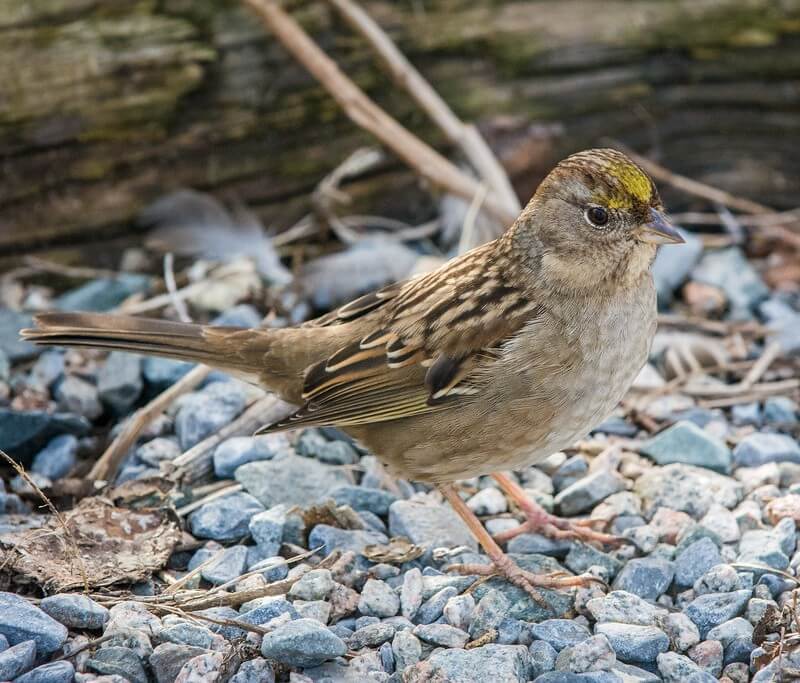
The Golden-crowned Sparrow is most often seen during the spring and winter in Oregon.
- Zonotrichia atricapilla
- Size: 7″ (18 cm)
- OR Checklist Frequency High: 28% in December
- OR Checklist Frequency Low: 1% in Summer
Identification and Color: In the summer, Golden-crowned Sparrows have a bright yellow forehead patch outlined in black. A grey to white underbelly and brown and black speckled wings. In the winter, the bright yellow and black head dulls in color. Short but thick bills. They have long tails.
Habitat and Behavior: Found along the west coast, breeding to the north on the coast and spending the winter on the south part. They can be found in forest edges, thickets, and shrubby areas. During migration, they can mix with large flocks of other sparrows. Will forage on the ground or low shrubs.
Diet: The Golden-crowned Sparrow mainly enjoys seeds and insects. Seeds include grass or weed and they may eat some spiders.
House Finch

The House Finch is a common bird across North America, seen year-round in Oregon.
- Carpodacus mexicanus
- Size: 5″ (13 cm)
- OR Checklist Frequency High: 27% in April
- OR Checklist Frequency Low: 17% in January
Identification and Color: Fairly small, measuring only about 5-6 inches long. House Finches are relatively easy to identify thanks to their characteristic red plumage near the eyes and throat. Males are typically redder than females, but both genders have distinctive streaks on their breast and belly.
Habitat and Behavior: House Finches are found in a variety of habitats, including woods, gardens, and open fields. A rather social bird that often travels in flocks. Can often be seen perching on power lines or fences in suburban areas.
Diet: House Finches are primarily seed eaters, but they will also consume insects and fruit on occasion.
House Sparrow

One of the most common backyard birds in Oregon. The House Sparrow is seen year-round.
- Passer domesticus
- Size: 6″ (15 cm)
- OR Checklist Frequency High: 13% in May
- OR Checklist Frequency Low: 6% in September
Identification and Color: A small plump bird with brown feathers and a grayish-plain breast. They have a black stripe on their face that extends from their bill to their throat. Wings are streaked with black and white.
Habitat and Behavior: Found in open areas with some trees nearby, such as farmland, parks, and suburban neighborhoods. They build their nests in holes in tree trunks or in man-made structures such as gutters, light fixtures, and nest boxes. House Sparrows are social birds that often form large flocks. You won’t be surprised to see them downtown near restaurants with outdoor seating!
Diet: House Sparrows eat mostly seeds and grains, but will also eat insects, berries, and other fruits. Happy to pick up crumbs and left over human food where available.
Killdeer

The Killdeer is typically seen in Oregon during the warmer months.
- Charadrius vociferous
- Size: 10″ (25 cm)
- OR Checklist Frequency High: 18% in September
- OR Checklist Frequency Low: 4% in January
Identification and Color: Mostly brown on the head and top of the body. The head is marked with black and white patches. A white underpart with two black stripes across it. An orange tail part can be seen when in flight. The Killdeer has a long tail and long wings. A small and short bill.
Habitat and Behavior: Located throughout North America. Southern birds are mostly permanent residents and northern birds will migrate. Killdeer like to be in very open areas of lawns, fields, and coastline. Spends the majority of time on the ground running around.
Diet: Insects make up the bulk of their diet. Beetles, grasshoppers, and caterpillars are frequent favorites. They may also eat a small number of seeds.
Mourning Dove

Mourning Doves are one of the most common birds in North America, and they can be found in a variety of habitats throughout Oregon.
- Zenaida macroura
- Size: 12″ (30 cm)
- OR Checklist Frequency High: 22% in May
- OR Checklist Frequency Low: 8% in January
Identification and Color: These slender birds have long, pointed tails and a tiny head. Brown and pale gray plumage with darker streaks on the wings and back.
Habitat and Behavior: Mourning Doves are relatively quiet birds, but they can often be heard cooing softly. Mourning Doves typically nest in trees, but they will also use man-made structures such as window ledges and gutters.
Diet: The Mourning Dove primarily eat seeds, but they will also eat insects and berries
Northern Flicker
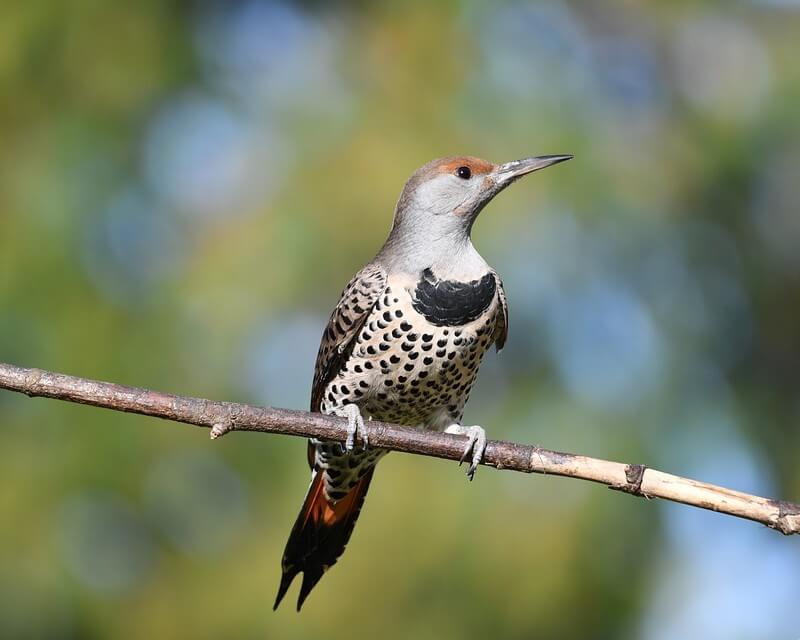
The Northern Flicker is seen year-round in Oregon.
- Colaptes auratus
- Size: 12″ (30 cm)
- OR Checklist Frequency High: 38% in March
- OR Checklist Frequency Low: 23% in June
Identification and Color: A fairly common large woodpecker, but size is where the similarities to other woodpeckers end. The male Northern Flicker is unique with a brown back, black bars and spotted breast. All North American Flickers have white rumps. There are also two different color groups of Northern Flickers – Yellow-shafted and Red-shafted. Yellow-shafted flickers have yellow underwings. Red-shafted flickers have reddish pink underwings.
Habitat and Behavior: Northern Flickers are hole-nesting birds, often making a home in a dead tree. Can be seen hopping around the ground while foraging or latched onto a tree eyeing a spot to search for food.
Diet: Northern Flickers mainly eat insects off the ground, but will also eat berries and nuts.
Red-breasted Nuthatch

The Red-breasted Nuthatch is a year-round resident of Oregon.
- Sitta canadensis
- Size: 4.5″ (11 cm)
- OR Checklist Frequency High: 22% in September
- OR Checklist Frequency Low: 10% in January
Identification and Color: These birds have a black patch at the top of their head and a black stripe over their eyes, with white in between the black on the head. The top of their bodies is a blue grey. In males the underparts are a strong reddish brown, females are paler in their colors. They are small birds with short tails and short, broad wings. They have long and pointed bills.
Habitat and Behavior: Some remain permanent residents throughout Canada and some migrate south into the United States for winter. Can be found in either coniferous or deciduous forests along mountainous areas as well. Forages by quickly moving around trees.
Diet: The Red-breasted Nuthatch mainly eats insects during the summer and seeds in the winter.
Red-winged Blackbird

The Red-winged Blackbird is a year-round resident of Oregon, especially near water areas.
- Agelaius phoeniceus
- Size: 8.5″ (22 cm)
- OR Checklist Frequency High: 34% in May
- OR Checklist Frequency Low: 10% in August
Identification and Color: A small black bird with a striking appearance. The male has black feathers and a red patch on each wing, while the female is mostly dark brown with vertical streaks.
Habitat and Behavior: These birds are found in open areas such as marshes, meadows, and fields. Often seen near water, where they build their nests. Red-winged Blackbirds are social birds and often form large flocks.
Diet: The Red-winged Blackbird diet consists of insects, spiders, and other small invertebrates. Will also eat seeds, fruits, and berries.
Song Sparrow

The Song Sparrow is a small bird commonly found during warmer months in Oregon.
- Melospiza melodia
- Size: 6″ (15 cm)
- OR Checklist Frequency High: 45% in April
- OR Checklist Frequency Low: 24% in August
Identification and Color: The Song Sparrow is brown and gray in color with streaks on its breast and a grayish-brown back. Gets its name from its loud melody.
Habitat and Behavior: Can be found in a variety of habitats including forests, grasslands, and wetlands. The Song Sparrow is a relatively shy bird, but will happily visit bird feeders if food is available.
Diet: Song Sparrows primarily eat insects, but will also eat seeds and berries.
Spotted Towhee

The Spotted Towhee can be seen during the warmer months in Oregon.
- Pipilo maculatus
- Size: 8″ (20 cm)
- OR Checklist Frequency High: 35% in April
- OR Checklist Frequency Low: 18% in August
Identification and Color: Males have black upperparts with spotted white on their backs. Females are gray-brown with the same spot pattern on their backs. Both sexes have a red-brown patch with white bellies. They have long rounded tails with white tips. Thick and pointed bills.
Habitat and Behavior: Found mainly in the Great Plains and the west half of the United States. Birds in the central north often migrate, and many are permanent residents of the south and west. Like to be in open areas that have a lot of shrubs and thick undergrowth. Mainly forages on the ground.
Diet: The Spotted Towhee eats insects, seeds, and berries. Their diet is dependent on the season with insects being eaten in the summer and seeds and berries in the winter.
Steller’s Jay

The Steller’s Jay is a year-round resident of Oregon.
- Sayornis saya
- Size: 7″ (18 cm)
- OR Checklist Frequency High: 31% in October
- OR Checklist Frequency Low: 16% in January
Identification and Color: Steller’s Jay can have either blue or white streaks on the front of their face depending on the region. They have a long and triangular crest that is black and gray patch that leads to blue bodies. They have rounded wings and long tails. A long and straight bill with a slight hook.
Habitat and Behavior: Permanent residents in their western locations, with only some moving if in high elevations. Found in evergreen forests they can also be in some more populated areas. Mostly forages high in the trees but will occasionally forage lower or on the ground.
Diet: Steller’s Jays are omnivorous. They eat mostly vegetarian with some insect and animal matter mixed into their diet.
Violet-green Swallow
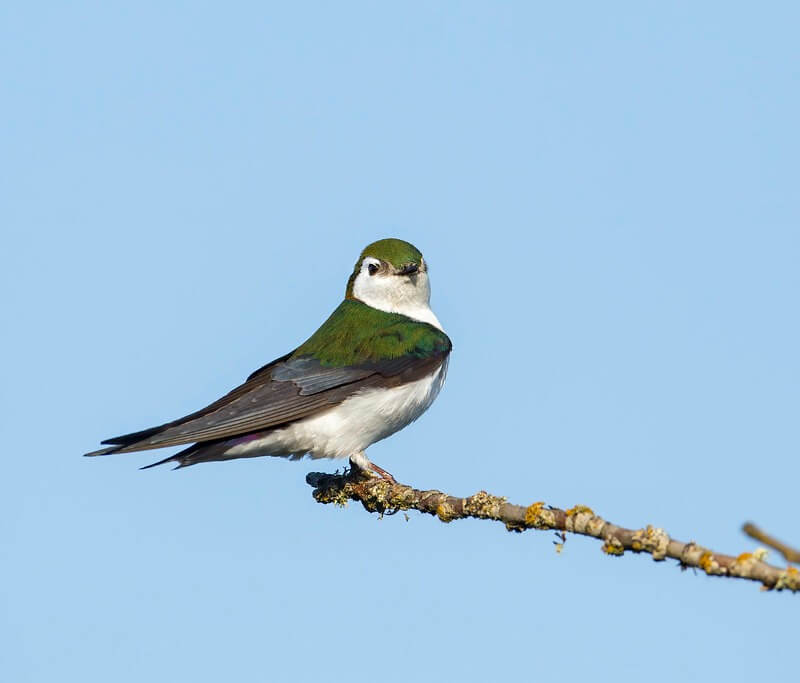
The Violet-green Swallow can be seen during the warmer months in Oregon.
- Tachycineta thalassina
- Size: 5″ (13 cm)
- OR Checklist Frequency High: 24% in May
- OR Checklist Frequency Low: 0% in Winter
Identification and Color: Both sexes have green and purple iridescent tops of heads and bodies. Both also have white bellies and darker wings and tail tips. The main difference between males and females is that males have white cheek patches and females have darker ones. They have long wings and forked tails. Their bills are very small and come to a point.
Habitat and Behavior: Spends the breeding and summer season all along the west half of North America. Migrates very far south into Mexico and beyond for the winter. Prefers open forests and will make nests in holes in trees. Very active and will fly at all different levels. Will forage in the air and usually in flocks.
Diet: Flying insects make up the majority of the Violet-green Swallow’s diet.
Western Meadowlark

The Western Meadowlark is the state bird of Oregon. Commonly seen during warmer months.
- Sturnella neglecta
- Size: 9″ (23 cm)
- OR Checklist Frequency High: 13% in May
- OR Checklist Frequency Low: 2% in August
Identification and Color: A bright yellow underpart that is marked with a black V in the summer and grey in the winter. Heavily streaked with brown, white, and black over their heads, top bodies, wings, and tails. They have short stiff tails and rounded wings. Bills are slender and long. They range about 6 to 9 inches in length.
Habitat and Behavior: The Western Meadowlark is a permanent resident in much of the west and midwest, the north-central states will see the birds migrate. Likes to be in open areas of grasslands and farms. Generally alone or in loose flocks. Will forage on the ground.
Diet: Insects and seeds make up the Western Meadowlarks’ diet.
White-breasted Nuthatch

The White-breasted Nuthatch can be found year-round in Oregon.
- Sitta carolinensis
- Size: 6″ (15 cm)
- OR Checklist Frequency High: 10% in September
- OR Checklist Frequency Low: 5% in May
Identification and Color: A stocky short-tailed bird. Has a black cap above an all white face and breast. Blueish upper parts.
Habitat and Behavior: The White-breasted Nuthatch can be found in forests, woodlands, and parks. Known for its acrobatic abilities, it can easily move up, down, and sideways on trees.
Diet: The White-breasted Nuthatch feeds on insects, spiders, and small nuts. Relies on seeds in the winter and will often cache them in a crevice for a later date.
White-crowned Sparrow

The White-crowned Sparrow is most often seen during the winter months in Oregon.
- Zonotrichia leucophrys
- Size: 6″ (15 cm)
- OR Checklist Frequency High: 37% in April
- OR Checklist Frequency Low: 6% in August
Identification and Color: Most White-crowned Sparrows have black and white stripes around their head. The underpart is gray. They have brown, black, and white coloring on their wings and tail. They have small, pointed bills. Long tails and rounded wings.
Habitat and Behavior: Breeds in the very far north and spends the winter in the very far south. Likes brushy places that are mixed with open and grassy areas. Usually stays low to the ground. Usually forages on the ground or in low shrubs. They usually forage in flocks.
Diet: The White-crowned Sparrow mainly enjoys seeds from weeds or grasses. Will also eat some vegetable matter and insects.
Yellow-rumped Warbler

The Yellow-rumped Warbler is most commonly seen in Oregon during the spring and fall.
- Dendroica coronata
- Size: 6″ (15 cm)
- OR Checklist Frequency High: 52% in April
- OR Checklist Frequency Low: 5% in August
Identification and Color: A small warbler with a soft song, all Yellow-rumped Warblers have a patch of yellow on their sides and rump (hence the name).
Habitat and Behavior: The Yellow-rumped Warbler is typically seen in large flocks during migration in the spring and fall. Enjoys larger open wooded areas as well as brush and thickets. Most often found in trees bearing needles and cones.
Diet: Enjoys insects and berries. Difficult to attract to feeders.
Conclusion
Oregon is a great place to observe a variety of backyard birds. From the colorful hummingbirds to the majestic woodpeckers, there are many species to be found in the state. These birds provide a great source of entertainment and education for birdwatchers of all ages. With a little bit of patience and knowledge, anyone can enjoy the beauty of these birds in their own backyard. Be sure to check out our other articles about birds in Oregon:
Remember to keep that feeder full and have your checklist ready! Before you go, take a moment to review some of our favorite Oregon birding resources:
